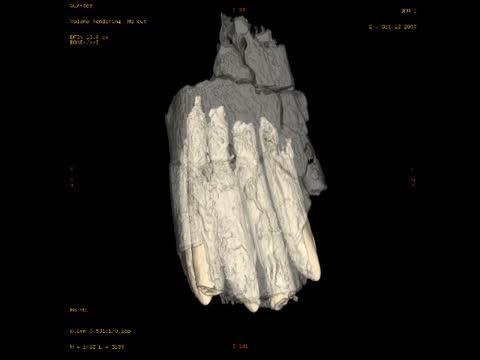Some Dinosaurs Grew New Teeth Every Couple of Months
Sauropods were the largest animals ever to live and their constantly replaced teeth helped them avoid wear from the greens they constantly munched on

CT scan of a Diplodocus Tooth. Photo: D’Emic et al., PLoS ONE
Like a shark or a crocodile, some dinosaurs, too, could replace lost teeth, researchers found. Sauropods—the group of long-necked dinosaurs that included Brontosaurus—most likely enjoyed an evolutionary edge thanks to this teeth-regenerating ability, the researchers think. What’s more, different species of sauropods regenerated teeth at different rates. This hints at a diversified plant diet among the sauropods, which may have allowed the large herbivores to co-exist in the same environment by avoiding competition with one another.
The BBC explains some of the sauropod teeth distinctions:
Researchers report that Diplodocus‘ teeth were replaced as often as once a month throughout the dinosaur’s life.
In contrast, the teeth of Camarasaurus, another sauropod, show less frequent replacement, but bulkier growth.
This suggests that Diplodocus fed off low-lying vegetation while Camarasaurus ate upper-canopy plants.
In order to arrive at these findings, the researchers non-destructively sampled sauropod fossil teeth with computed tomography scanning and microscopic anatomical methods. This allowed them to measure tooth formation, estimate replacement rate, count growth lines (the number of newly forming teeth) and determine crown volume and enamel thickness.
Sauropods were the largest animals ever to live, the authors conclude, and their constantly replaced teeth helped them avoid wear from the gargantuan amount of greens they constantly munched on, in addition to eking out species-specific niches in the environment.
More from Smithsonian.com:
/https://tf-cmsv2-smithsonianmag-media.s3.amazonaws.com/accounts/headshot/Rachel-Nuwer-240.jpg)
/https://tf-cmsv2-smithsonianmag-media.s3.amazonaws.com/accounts/headshot/Rachel-Nuwer-240.jpg)